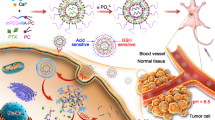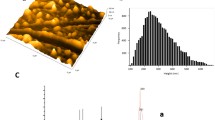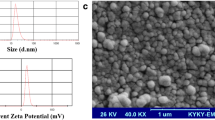Abstract
The harmful dose-dependent side effects of chemotherapy drugs have caused the discovery of novel perspective to evaluate chemotherapy protocols. In this study, the potential application of Compritol was investigated as a major scaffold into nanostructured lipid careers to highlight myricetin efficiency in treatment of breast cancer cells along with codelivery of docetaxel (DXT). Characterization of myricetin-loaded NLCs was carried out by measuring the particle size and zeta potential, using the scanning electron microscopy. MTT, DAPI staining, flow cytometric, and RT-PCR (real-time) assays were used to recognize novel formulation behavior on cell cytotoxicity as well as recognizing molecular mechanism of formulation concerning apoptosis phenomenon. Myricetin-loaded NLCs reduced the cell viability from 50 ± 2.3 to 40 ± 1.3% (p < 0.05). Percentage of apoptosis improved with combination treatment of myricetin-loaded NLCs and DXT in the MDA-MBA231 breast cancer cells. Expression of antiapoptotic genes (survivin, Cyclin B1, and Mcl1) indicated a significant reduction in factor along with increment in proapoptotic factor Bax and Bid mRNA rates. Overall, our results represented that the NLC delivery system could be a promising strategy to enhance the effect of anticancer agents such as DXT on breast cancer.








Similar content being viewed by others
References
Alshaker H, Pchejetski D (2018) PO-432 New combined nanoparticle therapy inhibits metastatic breast tumour growth with superior efficacy and lower side effect profile to docetaxel. BMJ Publishing Group Limited, pp A191–A192
Athawale RB, Jain DS, Singh KK, Gude RP (2014) Etoposide loaded solid lipid nanoparticles for curtailing B16F10 melanoma colonization in lung. Biomed Pharmacother 68:231–240
Bertrand N, Wu J, Xu X, Kamaly N, Farokhzad OC (2014) Cancer nanotechnology: the impact of passive and active targeting in the era of modern cancer biology. Adv Drug Deliv Rev 66:2–25
Bhattarai N, Mathis JM, Chen M, Perez RL, Siraj N, Magut PK, McDonough K, Sahasrabudhe G, Warner IM (2018) Endocytic selective toxicity of rhodamine 6G nanoGUMBOS in breast cancer cells. Mol Pharm 15:3837–3845
Devi KP, Rajavel T, Habtemariam S, Nabavi SF, Nabavi SM (2015) Molecular mechanisms underlying anticancer effects of myricetin. Life Sci 142:19–25
Feng J, Chen X, Wang Y, Du Y, Sun Q, Zang W, Zhao G (2015) Myricetin inhibits proliferation and induces apoptosis and cell cycle arrest in gastric cancer cells. Mol Cell Biochem 408:163–170
Fragni M, Bonini S, Bettinsoli P, Bodei S, Generali D, Bottini A, Spano P, Memo M, Sigala S (2016) The miR-21/PTEN/Akt signaling pathway is involved in the anti-tumoral effects of zoledronic acid in human breast cancer cell lines. Naunyn Schmiedeberg's Arch Pharmacol 389:529–538
Gadgil P, Shah J, Chow D-L (2018) Enhanced brain delivery with lower hepatic exposure of lazaroid loaded nanostructured lipid carriers developed using a design of experiment approach. Int J Pharm 544:265–277
Guo RX, Fu X, Chen J, Zhou L, Chen G (2016) Preparation and characterization of microemulsions of myricetin for improving its antiproliferative and antioxidative activities and oral bioavailability. J Agric Food Chem 64:6286–6294
Haddad A, Venkateswaran V, Viswanathan L, Teahan S, Fleshner N, Klotz L (2006) Novel antiproliferative flavonoids induce cell cycle arrest in human prostate cancer cell lines. Prostate Cancer Prostatic Dis 9:68–76
Hajipour H, Hamishehkar H, Nazari Soltan Ahmad S, Barghi S, Maroufi NF, Taheri RA (2018a) Improved anticancer effects of epigallocatechin gallate using RGD-containing nanostructured lipid carriers. Artif Cells Nanomed Biotechnol 46:283–292
Hajipour H, Hamishehkar H, Rahmati-Yamchi M, Shanehbandi D, Ahmad SNS, Hasani A (2018b) Enhanced anti-cancer capability of ellagic acid using solid lipid nanoparticles (SLNs). IJCM 11
Hatakeyama H, Akita H, Harashima H (2011) A multifunctional envelope type nano device (MEND) for gene delivery to tumours based on the EPR effect: a strategy for overcoming the PEG dilemma. Adv Drug Deliv Rev 63:152–160
Huang H, Chen AY, Ye X, Li B, Rojanasakul Y, Rankin GO, Chen YC (2015) Myricetin inhibits proliferation of cisplatin-resistant cancer cells through a p53-dependent apoptotic pathway. Int J Oncol 47:1494–1502
Khazir J, Riley DL, Pilcher LA, De-Maayer P, Mir BA (2014) Anticancer agents from diverse natural sources. Nat Prod Commun 9: 1934578X1400901130
Ko C-H, Shen S-C, Lee TJ, Chen Y-C (2005) Myricetin inhibits matrix metalloproteinase 2 protein expression and enzyme activity in colorectal carcinoma cells. Mol Cancer Ther 4:281–290
Lee DH, Lee CS (2016) Flavonoid myricetin inhibits TNF-α-stimulated production of inflammatory mediators by suppressing the Akt, mTOR and NF-κB pathways in human keratinocytes. Eur J Pharmacol 784:164–172
López-Lázaro M, Willmore E, Austin CA (2010) The dietary flavonoids myricetin and fisetin act as dual inhibitors of DNA topoisomerases I and II in cells. Mutat Res Genet Toxicol Environ Mutagen 696:41–47
Lu J, Papp LV, Fang J, Rodriguez-Nieto S, Zhivotovsky B, Holmgren A (2006) Inhibition of mammalian thioredoxin reductase by some flavonoids: implications for myricetin and quercetin anticancer activity. Cancer Res 66:4410–4418
Mahmoudi S, Ghorbani M, Sabzichi M, Ramezani F, Hamishehkar H, Samadi N (2019) Targeted hyaluronic acid-based lipid nanoparticle for apigenin delivery to induce Nrf2-dependent apoptosis in lung cancer cells. J Drug Delivery Sci Technol 49:268–276
Martins S, Sarmento B, Ferreira DC, Souto EB (2007) Lipid-based colloidal carriers for peptide and protein delivery–liposomes versus lipid nanoparticles. Int J Nanomedicine 2:595
Mennini N, Cirri M, Maestrelli F, Mura P (2016) Comparison of liposomal and NLC (nanostructured lipid carrier) formulations for improving the transdermal delivery of oxaprozin: effect of cyclodextrin complexation. Int J Pharm 515:684–691
Minaei A, Sabzichi M, Ramezani F, Hamishehkar H, Samadi N (2016) Co-delivery with nano-quercetin enhances doxorubicin-mediated cytotoxicity against MCF-7 cells. Mol Biol Rep 43:99–105
Mohammadian J, Sabzichi M, Molavi O, Shanehbandi D, Samadi N (2016) Combined treatment with stattic and docetaxel alters the Bax/Bcl-2 gene expression ratio in human prostate cancer cells. APJCP 17:5031
Oh E-T, Kim CW, Kim SJ, Lee J-S, Hong S-S, Park HJ (2016) Docetaxel induced-JNK2/PHD1 signaling pathway increases degradation of HIF-1α and causes cancer cell death under hypoxia. Sci Rep 6:27382
Phillips P, Sangwan V, Borja-Cacho D, Dudeja V, Vickers S, Saluja A (2011) Myricetin induces pancreatic cancer cell death via the induction of apoptosis and inhibition of the phosphatidylinositol 3-kinase (PI3K) signaling pathway. Cancer Lett 308:181–188
Raeisi S, Chavoshi H, Mohammadi M, Ghorbani M, Sabzichi M, Ramezani F (2019) Naringenin-loaded nano-structured lipid carrier fortifies oxaliplatin-dependent apoptosis in HT-29 cell line. Process Biochem 83:168–175
Sabzichi M, Mohammadian J, Ghorbani M, Saghaei S, Chavoshi H, Ramezani F, Hamishehkar H (2017a) Fabrication of all-trans-retinoic acid-loaded biocompatible precirol: a strategy for escaping dose-dependent side effects of doxorubicin. Colloids Surf B: Biointerfaces 159:620–628
Sabzichi M, Mohammadian J, Mohammadi M, Jahanfar F, Movassagh Pour AA, Hamishehkar H, Ostad-Rahimi A (2017b) Vitamin D-loaded nanostructured lipid carrier (NLC): a new strategy for enhancing efficacy of doxorubicin in breast cancer treatment. Nutr Cancer 69:840–848
Shih Y-W, Wu P-F, Lee Y-C, Shi M-D, Chiang T-A (2009) Myricetin suppresses invasion and migration of human lung adenocarcinoma A549 cells: possible mediation by blocking the ERK signaling pathway. J Agric Food Chem 57:3490–3499
Üner M, Wissing S, Yener G, Müller R (2004) Influence of surfactants on the physical stability of solid lipid nanoparticle (SLN) formulations. Pharmazie 59:331–332
Wang S, Ye T, Zhang X, Yang R, Yi X (2013) Myricetin microemulsion for oral drug delivery: formulation optimization, in situ intestinal absorption and in-vivo evaluation. Asian J Pharm Sci 8:18–27
Zhang X-H, Zou Z-Q, Xu C-W, Shen Y-Z, Li D (2011) Myricetin induces G2/M phase arrest in HepG2 cells by inhibiting the activity of the cyclin B/Cdc2 complex. Mol Med Rep 4:273–277
Funding
This project was financially supported by a grant from the Student Research Committee, Tabriz University of Medical Sciences, Tabriz, Iran (grant no. 58991).
Author information
Authors and Affiliations
Contributions
N.F.M. and V.V. had the main contribution in conception and design and are involved in the performance of experiments, data analysis and interpretation, and manuscript writing; S.A.M.M. and H.K. are involved in the data analysis and manuscript writing; K.W., R.B., F.R., and M.G. are involved in some molecular experiments; M.A. and H.H. are involved in data analysis and interpretation. S.G. and M.S. are involved in the performance of all experiments.
Corresponding authors
Ethics declarations
Conflict of interest
The authors declare that they have no conflict of interest.
Additional information
Publisher’s note
Springer Nature remains neutral with regard to jurisdictional claims in published maps and institutional affiliations.
Rights and permissions
About this article
Cite this article
Maroufi, N.F., Vahedian, V., Mazrakhondi, S.A.M. et al. Sensitization of MDA-MBA231 breast cancer cell to docetaxel by myricetin loaded into biocompatible lipid nanoparticles via sub-G1 cell cycle arrest mechanism. Naunyn-Schmiedeberg's Arch Pharmacol 393, 1–11 (2020). https://doi.org/10.1007/s00210-019-01692-5
Received:
Accepted:
Published:
Issue Date:
DOI: https://doi.org/10.1007/s00210-019-01692-5




